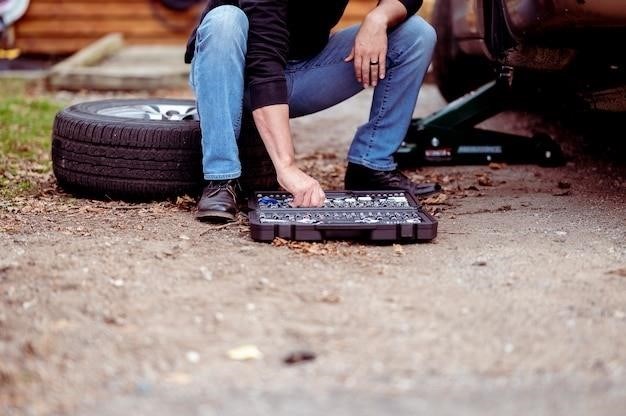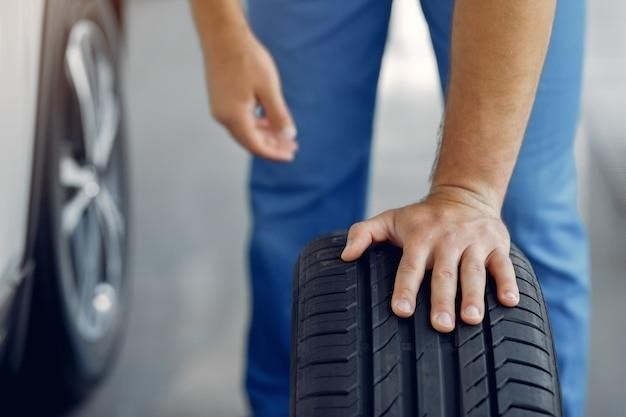Mickey Thompson Tire Pressure Guide⁚ An Overview
Maintaining correct tire pressure is crucial for optimal performance, safety, and tire longevity with Mickey Thompson tires. Understanding load capacity, tire size, and application is essential for determining the appropriate inflation pressure. Consult resources and experts for guidance, and never exceed the maximum inflation pressure indicated on the tire sidewall.
Understanding Load Capacity and Tire Selection
Choosing the right Mickey Thompson tire involves careful consideration of load capacity. For light trucks, load capacity is paramount when selecting non-OE sizes, exceeding the importance of load range. Mickey Thompson advises against using P-metric tires on applications originally fitted with LT tires due to reduced load capacity in P-metric options. This is because P-metric tires, designed for passenger vehicles, lack the robust construction and higher load ratings of LT tires, which are specifically engineered for heavier loads and tougher off-road conditions. Always check your vehicle’s owner’s manual or consult a tire professional to determine the appropriate load capacity for your specific needs and vehicle type. Incorrect tire selection can compromise safety and handling, so making an informed decision is critical.
Importance of Correct Tire Pressure
Maintaining proper tire pressure in your Mickey Thompson tires is paramount for several reasons. Underinflation leads to increased rolling resistance, resulting in reduced fuel efficiency and potentially premature tire wear. It also compromises handling and stability, increasing the risk of accidents. Conversely, overinflation can cause a harsh ride, reduced traction, and increased risk of tire damage from impacts. The correct tire pressure ensures optimal contact between the tire and the road surface, maximizing traction and handling. Regularly checking and adjusting tire pressure according to the manufacturer’s recommendations, considering factors like load and environmental conditions, is crucial for safety, performance, and extending the life of your Mickey Thompson tires. Remember that the pressure listed on the tire sidewall represents the maximum pressure, not necessarily the recommended pressure for everyday driving.
Factors Affecting Tire Pressure⁚ Size and Application
Several factors influence the ideal tire pressure for your Mickey Thompson tires beyond the basic recommendations. Tire size plays a significant role; larger tires generally require higher pressures to maintain the proper load capacity. The intended application is equally important. Off-road use, for example, may necessitate lower pressures for increased traction on soft surfaces like sand or mud, while higher pressures might be preferable for highway driving to improve fuel economy and handling. Load capacity is another critical factor; heavier loads require higher inflation pressures to prevent overloading and potential tire failure. Ambient temperature also affects tire pressure; cold temperatures reduce pressure, while hot temperatures increase it. Regularly checking and adjusting your tire pressure, taking into account these variables, ensures optimal performance and safety with your Mickey Thompson tires, regardless of the conditions.

Mickey Thompson Tire Compounds and Their Uses
Mickey Thompson tires utilize various compounds tailored to specific applications. The compound is identified within the tire’s serial number. A compound chart details each compound’s intended use, from off-road to street performance. Understanding this helps select the right tire for your needs.
Deciphering the Serial Number
Each Mickey Thompson tire features a serial number containing vital information, including the tire compound. This alphanumeric code provides a concise summary of the tire’s specifications and manufacturing details. Understanding how to decode this number is crucial for determining the appropriate tire pressure and performance characteristics. The serial number typically includes a code representing the tire’s compound, allowing you to cross-reference it with Mickey Thompson’s compound chart to understand its intended use and properties. This information is key for selecting the correct inflation pressure for optimal handling, traction, and tire life. For example, in a serial number like “CY1J M5 FJ087,” “M5” denotes the specific rubber compound used in the tire’s construction. By correctly interpreting this code, you can ensure you’re using the tire in its intended application, maximizing its performance and safety. Refer to Mickey Thompson’s official resources or contact their technical support for detailed explanations and assistance in deciphering your tire’s serial number.
Compound Chart and Intended Applications
Mickey Thompson utilizes various tire compounds, each formulated for specific applications and performance characteristics. A comprehensive compound chart details the different rubber compounds used in their tire line-up, correlating each compound to its intended use. This chart is essential for understanding the optimal operating conditions and recommended inflation pressures for each tire. Different compounds offer varying levels of traction, durability, and heat resistance, influencing the optimal pressure range. For instance, a compound designed for off-road use might require lower pressures for maximum traction on loose surfaces, while a compound for high-speed street driving might necessitate higher pressures for stability and reduced rolling resistance. Consulting this chart ensures the correct tire pressure is used for the intended application, maximizing performance and safety. The chart will typically specify the compound code (e.g., M5), along with its intended application (e.g., off-road, street, racing). This information is critical for safe and effective operation of your Mickey Thompson tires.
Mickey Thompson Tire Models and Pressure Recommendations
This section details recommended tire pressures for various Mickey Thompson tire models, including the Baja Boss A/T, ET Street Radial, and Sportsman S/R Radial. Specific pressures vary based on tire size, load, and intended use (on-road, off-road, racing).
Baja Boss A/T: Pressure and Performance
The Mickey Thompson Baja Boss A/T tire, renowned for its aggressive tread and hybrid A/T design, demands careful attention to tire pressure for optimal performance. This tire boasts a 50,000-mile treadwear warranty and 3PMSF designation, highlighting its durability and all-weather capabilities. However, achieving peak performance requires understanding the interplay between pressure and driving conditions. For on-road use, maintaining the recommended pressure ensures a smooth ride, optimal fuel economy, and even tread wear. Off-road, slightly lower pressures might be beneficial for increased traction on challenging terrains like sand or loose gravel. Always consult the Mickey Thompson tire pressure chart for your specific Baja Boss A/T size and load rating before adjusting pressure. Remember that exceeding the maximum pressure listed on the tire sidewall is dangerous and can lead to tire failure. The correct pressure ensures maximum grip and handling while preventing premature wear and tear. Regularly checking and adjusting tire pressure is vital for extending tire lifespan and enjoying the Baja Boss A/T’s full potential.
ET Street Radial⁚ On-Track and Highway Pressures
Mickey Thompson ET Street Radial tires are designed for high-performance applications, demanding specific pressure adjustments depending on the environment. On the racetrack, achieving optimal grip and minimizing tire wear requires careful pressure management. Starting pressures below 13 psi are strongly discouraged; recommended track pressures typically range from 14 to 18 psi. However, these pressures can be further fine-tuned based on track conditions, ambient temperature, and driving style. For street use, significantly higher pressures are needed for a safe and comfortable ride. Consult the Mickey Thompson tech department at (800) 222-9092 (Option 5) for recommended highway inflation pressures tailored to your specific tire size and vehicle. Remember that the pressure marked on the tire sidewall represents the maximum permissible inflation, not the recommended operating pressure for highway driving. Using excessively high or low pressures can negatively impact handling, tread life, and overall tire performance. Always check and adjust tire pressure before every track day and regularly for street use to ensure safe and effective operation of your ET Street Radial tires.
Sportsman S/R Radial⁚ Light Street Driving Pressures
The Mickey Thompson Sportsman S/R Radial tire, while suitable for light street driving, requires careful consideration of tire pressure for optimal performance and safety. Unlike high-performance racing tires, the Sportsman S/R Radial doesn’t necessitate extremely low pressures. A range of 32-35 PSI is generally considered appropriate for everyday street use, offering a balance between ride comfort and handling. However, this is just a guideline; the ideal pressure may vary depending on factors such as vehicle weight, load, and ambient temperature. Always check your tire pressure regularly and adjust accordingly. Over-inflation can lead to a harsh ride and premature wear, while under-inflation compromises handling and increases the risk of tire damage. Before embarking on longer journeys or carrying heavy loads, slightly increasing the tire pressure can improve fuel efficiency and handling stability. Remember to always consult your vehicle’s owner’s manual for recommended tire pressures and never exceed the maximum inflation pressure indicated on the tire sidewall. Regular pressure checks are crucial to ensure the long-term performance and safety of your Sportsman S/R Radial tires.

Finding the Right Pressure for Your Mickey Thompson Tires
Accurate tire pressure is vital. Consult the owner’s manual and the tire sidewall for maximum pressure. Consider load, temperature, and driving conditions for adjustments. Don’t exceed the maximum.
Consulting Resources and Experts
For precise pressure recommendations tailored to your specific Mickey Thompson tires and vehicle, several valuable resources are available. Start with your vehicle’s owner’s manual; it often provides a starting point for tire pressures based on your vehicle’s specifications and recommended tire sizes. Mickey Thompson’s official website is another excellent resource. Their website typically features detailed tire specifications, including recommended inflation pressures for various models and applications. You might find helpful charts or guides that provide pressure recommendations based on factors like tire load, speed rating, and intended use (on-road, off-road, racing, etc.).
If you can’t find the information you need online, contacting Mickey Thompson’s customer service directly is a great option. Their experts can provide personalized guidance based on your particular tire model, vehicle type, and driving conditions. Local tire shops specializing in off-road or performance tires are also valuable resources; Experienced technicians at these shops can assess your tires, vehicle, and driving habits to recommend the most suitable inflation pressure. Remember, always prioritize safety and ensure your tire pressure is within the recommended range to maintain optimal performance and tire longevity.
Using the Maximum Inflation Pressure
The maximum inflation pressure, often found printed on your Mickey Thompson tire sidewall, represents the absolute highest pressure the tire can safely handle. It’s crucial to understand that this is not a recommendation for everyday driving. Using the maximum pressure consistently can lead to a harsher, less comfortable ride, reduced traction, and increased risk of tire damage. Overinflation makes the tire’s contact patch with the road smaller, reducing grip and potentially causing uneven wear. It also increases the risk of sidewall damage and blowouts, especially on rough terrain or during high-speed driving.
The maximum pressure is primarily a safety guideline, ensuring the tire doesn’t structurally fail under extreme conditions. It’s designed for temporary situations, such as carrying heavy loads for short distances or transporting heavy equipment where higher pressure might be necessary. For standard driving, always refer to the recommended inflation pressure, considering factors such as your vehicle’s load, tire size, and driving conditions. Consult your vehicle’s owner’s manual, the Mickey Thompson website, or a tire professional for guidance to ensure your tires are properly inflated for a safe and comfortable driving experience.